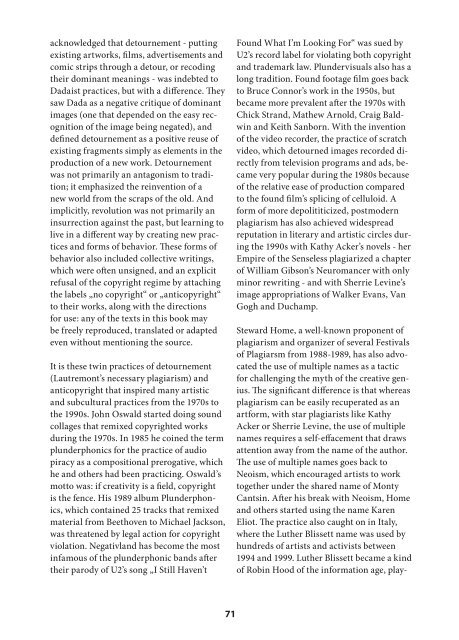Create successful ePaper yourself
Turn your PDF publications into a flip-book with our unique Google optimized e-Paper software.
acknowledged that detournement - putting<br />
existing artworks, films, advertisements and<br />
comic strips through a detour, or recoding<br />
their dominant meanings - was indebted to<br />
Dadaist practices, but with a difference. They<br />
saw Dada as a negative critique of dominant<br />
images (one that depended on the easy recognition<br />
of the image being negated), and<br />
defined detournement as a positive reuse of<br />
existing fragments simply as elements in the<br />
production of a new work. Detournement<br />
was not primarily an antagonism to tradition;<br />
it emphasized the reinvention of a<br />
new world from the scraps of the old. And<br />
implicitly, revolution was not primarily an<br />
insurrection against the past, but learning to<br />
live in a different way by creating new practices<br />
and forms of behavior. These forms of<br />
behavior also included collective writings,<br />
which were often unsigned, and an explicit<br />
refusal of the copyright regime by attaching<br />
the labels „no copyright“ or „anticopyright“<br />
to their works, along with the directions<br />
for use: any of the texts in this book may<br />
be freely reproduced, translated or adapted<br />
even without mentioning the source.<br />
It is these twin practices of detournement<br />
(Lautremont’s necessary plagiarism) and<br />
anticopyright that inspired many artistic<br />
and subcultural practices from the 1970s to<br />
the 1990s. John Oswald started doing sound<br />
collages that remixed copyrighted works<br />
during the 1970s. In 1985 he coined the term<br />
plunderphonics for the practice of audio<br />
piracy as a compositional prerogative, which<br />
he and others had been practicing. Oswald’s<br />
motto was: if creativity is a field, copyright<br />
is the fence. His 1989 album Plunderphonics,<br />
which contained 25 tracks that remixed<br />
material from Beethoven to Michael Jackson,<br />
was threatened by legal action for copyright<br />
violation. Negativland has become the most<br />
infamous of the plunderphonic bands after<br />
their parody of U2’s song „I Still Haven’t<br />
71<br />
Found What I’m Looking For“ was sued by<br />
U2’s record label for violating both copyright<br />
and trademark law. Plundervisuals also has a<br />
long tradition. Found footage film goes back<br />
to Bruce Connor’s work in the 1950s, but<br />
became more prevalent after the 1970s with<br />
Chick Strand, Mathew Arnold, Craig Baldwin<br />
and Keith Sanborn. With the invention<br />
of the video recorder, the practice of scratch<br />
video, which detourned images recorded directly<br />
from television programs and ads, became<br />
very popular during the 1980s because<br />
of the relative ease of production compared<br />
to the found film’s splicing of celluloid. A<br />
form of more depolititicized, postmodern<br />
plagiarism has also achieved widespread<br />
reputation in literary and artistic circles during<br />
the 1990s with Kathy Acker’s novels - her<br />
Empire of the Senseless plagiarized a chapter<br />
of William Gibson’s Neuromancer with only<br />
minor rewriting - and with Sherrie Levine’s<br />
image appropriations of Walker Evans, Van<br />
Gogh and Duchamp.<br />
Steward Home, a well-known proponent of<br />
plagiarism and organizer of several Festivals<br />
of Plagiarsm from 1988-1989, has also advocated<br />
the use of multiple names as a tactic<br />
for challenging the myth of the creative genius.<br />
The significant difference is that whereas<br />
plagiarism can be easily recuperated as an<br />
artform, with star plagiarists like Kathy<br />
Acker or Sherrie Levine, the use of multiple<br />
names requires a self-effacement that draws<br />
attention away from the name of the author.<br />
The use of multiple names goes back to<br />
Neoism, which encouraged artists to work<br />
together under the shared name of Monty<br />
Cantsin. After his break with Neoism, Home<br />
and others started using the name Karen<br />
Eliot. The practice also caught on in Italy,<br />
where the Luther Blissett name was used by<br />
hundreds of artists and activists between<br />
1994 and 1999. Luther Blissett became a kind<br />
of Robin Hood of the information age, play-


